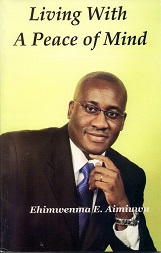
Lil Joe wrote:
The parasitic economic interests of indigenous African chiefs and kings
were the basis of the tribal "indigenous African institutions and value
systems". It was in the framework of the "indigenous African
institutions and value
systems" that my ancestors were sold to European slavers, and why I am
in America today. And you want to go back to that? Obviously I don't.
***********
Lil Joe,
I feel compelled to respond to this, not to whitewash or blackwash
(choose which verb applies) an ignoble practice that saw millions
shackled and deprived of basic dignity. Rather, it is to dispel certain
myths pertaining to the participation of our ancestors in the slave
trade.


MYTH No. 1: Africans were selling themselves off into slavery before the
Europeans on the continent.
It is true there was slavery in Africa but not the inhumane chattel
variety. Slaves in Africa enjoyed certain rights and privileges.
Generally, there were no slave markets in black Africa because of the
value black Africans place on humanity. The slave markets that were in
Africa, according to historians, were in North Africa (or Arab North
Africa) - in such places as Fez and Tripoli.
Slaves generally were principally war captives from inter-tribal
warfare. Say there was a war between two neighboring tribes - the
Ashanti and the Fante -- and 5,000 Fantes were taken prisoner. The
Ashanti King had the following options:
1. To keep the 5,000 Fantes in prison, which means he would have to
feed, clothe and shelter them - an expensive economic proposition;
2. To kill them, a very inhumane prospect; or
3. Sell them off as slaves and use the proceeds to purchase weapons to
defend his Ashanti people;
4. Absorb and integrate the war captives into Ashanti society, a long,
arduous and dangerous process since safeguards must be put in place to
ensure that former combatants would pledge allegiance to a new society
and authority.
Which option do you think the Ashanti King would take? If you said the
third option, you are right because it was the most humane and
economically expedient. The Ashanti also choose option 4, absorbed
former war captives (slaves) into their society. To make their
integration into Ashanti society as smooth as possible, even the Ashanti
King was forbidden to disclose the slave origins of any of his subjects.
Now, the more important issue is this. YES, the Ashanti King did sell
Fante prisoners of war as SLAVES and therefore participated in the slave
trade. BUT the Ashanti King did NOT sell his own people - an important
distinction. It was the Europeans who failed to make this distinction,
which has been the source of much mythology about the slave trade.
The Europeans made no distinction between the Ashanti King and the Fante
slaves. To the Europeans, it was a BLACK African King selling BLACK
Africans. Therefore, Black kings and chiefs were selling their own kind
or people. Nonsense. To the Ashanti King, the Fantes were NOT his people
but rather the Ashanti.
Recall that about that time in history, medieval Europe was also
fighting tribal wars - between the Flemish, French and the Germans. They
were also enslaving one another. But you don't hear the expression, "The
Europeans were enslaving their own kind?" do you? Rather, you read of
Germans taking French slaves and vice versa. So make the same
distinctions in Africa - The Ashanti King taking Fante slaves, etc.
MYTH NO.2. "African chiefs just went to the market and just grabbed his
people to sell off as slaves."
You often hear this from African Americans but it is not true. In fact,
no African chief can do this and expect to remain chief. He would be
removed. As chief, his prerogative is the survival of his tribe. He
would be committing an ethnic suicide if he were to sell off his own
Ashanti people into slavery. Besides, there were traditional injunctions
against that. Furthermore, as Ashanti King or chief, one of his role is
to minimize any external threat to his people. And if this means
depopulating or selling off the entire Fante tribe into slavery the
better off his Ashanti people would be. It would mean less competition
for resources.
MYTH No. 3. "Africans are brothers and sisters and it is treacherous for them to participate in the slave trade."
Again, tribal or ethnic distinctions are important in Africa. To think
that Africans consider members of another tribe as "brothers and
sisters" is an exercise in grand delusion. Why would a Hutu government
in Rwanda slaughter more than 800,000 Tutsis in Rwanda in 1994?
Before the twentieth century, many societies in the world practiced some
form of slavery. Prisoners of war, political opponents and religious
dissidents were often enslaved in Old England. For example, in 1530, in
England, under the reign of Henry VIII, a vagrant picked up for the
second time was whipped and had half an ear cut off; taken for a third
time, he was "to be executed as a hardened criminal and enemy of the
common weal" (Marx, 1915; p.806). Seventy-two thousand vagrants were
thus executed during that reign. In the time of Edward VI (1547), "if
anyone refused to work, he shall be condemned as a slave to the person
who denounced him as an idler" (Marx, 1915; p.806). The owner of such a
slave might whip him, chain him, and brand him on the cheek and forehead
with a letter "S" (for Slave), if he disappeared for two weeks. If he
ran away a third time he was executed. An idler vagabond caught on the
highway was branded on the chest with a "V" (for vagrant). The same laws
were in effect during the reigns of Elizabeth (1572) and of Louis XVI in
France. The supporters of Monmouth's rebellion in England were sold by
the Queen. Cromwell's Irish and Scottish prisoners were sold to the
West Indies and non Muslims who opposed the Sokoto jihad were sold to
North Africa.
Criminals in Europe and Africa could be executed, transported or sold.
Europeans favored execution; Africans favored sale.
"In the eighteenth century there were 300 different offences in Britain
for which one could be executed. In Dahomey, there were only two, for
the king preferred to sell rather than execute his troublemakers. Those
who could not pay their debts were sold for life or until the debt was
paid. Among the Yoruba, debt slaves (pawns) were called Iwofa, among the
Asante Awowa, and among the Europeans indentured servants. About a
quarter of a million white debt slaves entered America before the
nineteenth century" (Boahen and Webster, 1970; p.69).
In pre colonial Africa, social conditions were such that,
"All the white minorities living in Africa might own Black slaves, but
slaves and white masters alike were all subjects of a Black Emperor:
they were all under the same African political power. No historian worth
his salt can permit the obscuring of this politico social context, so
that only the one fact of Black slavery emerges from it" (Diop, 1987;
p.92).
There was, however, an important distinction between the slave/master
relationship in Africa and that in Europe between serf/lord, which is
often overlooked. In Africa, slavery was more of a social distinction
without economic consequence than fact. The African slave, "instead of
being deprived of the fruits of his labor, as was the case with the
artisan or the serf of the Middle Ages, could, on the contrary, add to
it wealth given him by the `lord'" (Diop, 1987: p.2). Slaves of the
kings of Mali and the Askias of Gao "enjoyed complete liberty of
movement. Thus an ordinary slave of Askia Daud, a native of Kanta, was
able to carry out a pilgrimage to Mecca without his master's knowledge"
(Diop, 1987; p.153).
To avoid the ugly connotations associated with commercial slaving,
Vaughan (1986) suggested the use of limbry: "Existing data, albeit
tenuous, suggest that about 80 percent of African societies had limbry"
(p.174). In contrast to commercial slavery, African "limbries" "were not
on the whole mistreated, dehumanized or exploited" (Vaughan, 1986;
p.174).
The privileges accorded them, however, varied from tribe to tribe. In
Nigeria, the treatment of slaves was by no means harsh; nor was their
lot deplorable. The majority were integrated into the society and the
respective families of their owners in order to retain their loyalty,
prevent rebellion and get the best out of them (Falola, 1985; p.99). The
slaves were free to some extent; they could intermarry among themselves,
own property and redeem themselves if they had the means.
Among the Lobi of Gabon, slaves were considered as "new children." The
Massangou of the Chaillou Hills in Gabon, incorporated slaves (war
captives) into the entire community to replace those lost in war. In
Dahomey, the children of slaves were free people incorporated into the
master's family with all the rights except the right to inherit
political leadership (Simiyu, 1988; p.59). But in Senegal, slaves (djem)
were closely associated to power. They were represented in royal courts
and many became de facto ministers (Diop, 1987:2).
More importantly, Boahen and Webster (1970) pointed out that:
"Slaves had many privileges in African kingdoms. In Asante, Oyo and
Bornu, they held important offices in the bureaucracy, serving as the
Alafin's Ilari in the subject towns of Oyo, as controller of the
treasury in Asante, and as Waziri and army commanders in Bornu. Al Hajj
Umar made a slave emir of Nioro, one of the most important of the
emirates of the Tokolor empire, and in the Niger Delta states slaves
rose to become heads of Houses, positions next in rank to the king.
Jaja, who had once been the lowest kind of slave, became the most
respected king in the delta, and was no exception; one of the Alaketus
of Ketu, and Rabeh of Bornu, rose from slave to king" (p.69).
Since slaves faced few barriers to occupational mobility or economic
advancement, there was hardly any need for a tumultuous social
revolution, such as the French Revolution in which the exploited
overthrew their lords. "Slavery, of course, was never under any
circumstances an ideal institution and there were cases of slave
revolts. One example was the revolt under Afonja in the Oyo empire.
Another was the Koranko revolt in 1838 against the Susu of Sierra Leone.
Led by Bilale, the Koranko ex slaves built a fortified town to offer
freedom to runaway slaves. In Calabar, the slaves united in an
organization called the Blood Men, and forced the freeborn to respect
their human rights" (Boahen and Webster, 1970; p.70).
George B.N. Ayittey,
Washington, DC